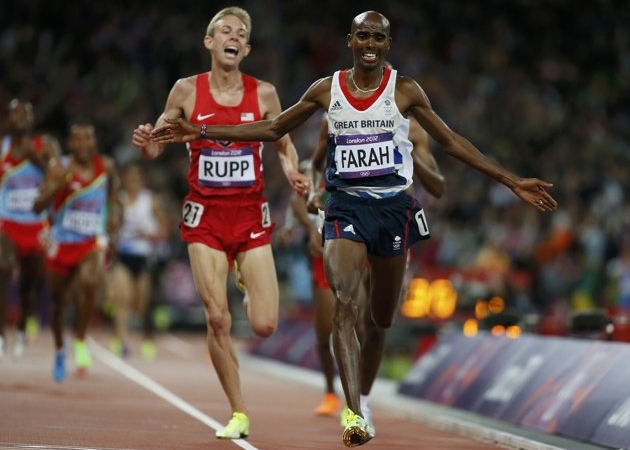Last weekend, the history book was rewritten when Mo Farah and Galen Rupp finished first and second in the Olympic 10k.

Farah became the first British athlete to ever medal in the men’s 10k while Galen Rupp became the first American to medal in the event since Billy Mills’ upset victory in 1964.
Both runners out-sprinted the 5k and 10k world record holder (and two-time Olympic gold medalist) Keninisa Bekele, who is known for his devastating kick. Mo Farah’s final 400m was a staggering 53.8 seconds. And Rupp was closing on him.
Bekele said after the race:
“I knew they were dangerous. But I can’t stop them.”
One of the many aspects of this race that make it so exciting is that Farah and Rupp are training partners under coach Alberto Salazar of the Nike Oregon Project based in Portland, Oregon. They’ve trained together for about a year and a half and each has seen tremendous success recently.
Since they train together – and then went 1-2 in one of track & field’s most difficult races – we can pull some valuable insights from these performances.
This historical race provides a glimpse into phenomenal training, well-executed race tactics, and lessons that go beyond elite athletes. All of us can use this 10k race as guidance in our own training.
Below are several lessons that I took from this race – I’d love to hear any more than you can think of in the comments.
Specificity trumps general training
Every good coach knows that to run well in any event you have to prioritize race-specific fitness. Focus on developing the tools you’ll need on race day (which will be different depending on the distance that you’re focusing on).
Salazar knew that his athletes would need an outstanding finishing kick to contend for a medal in London. During practice, Rupp finished his interval workouts with maximum effort repetitions. Two examples include a 51 second 400m and a 11.03 100m (!!) that included a two-step running start. What 10,000m distance runner can run an 11 second 100m?!
Those interval times are not just impressive – they’re one-of-the-best-in-the-world impressive.
Training suggestions:
- Whatever your race, practice the physical demands during training (fast finish, marathon-specific long runs, 5k pace, etc.)
- Specificity carries over to more than just pace, it also includes elevation changes, terrain, shoe choice, etc.
Teamwork helps you reach new levels of performance
Both Farah and Rupp have trained together for well over a year, running together regularly and focusing on the same events. During the Olympic 10k, they worked together to stay out of trouble early in the race, conserve energy when they needed it, and sprint to the finish during the final 400m.
When you train with a partner of similar ability, you not only push each other to reach new heights, but you become more confident of your own ability during a race. You can feed off each other’s energy and use teamwork to help one another succeed.
Training suggestions:
- If it’s available to you, club workouts can give you extra motivation and the training partners you need
- Get to know the runners in your area through group runs hosted by running specialty stores
Distance runners have to sprint (I told you so!)
Elite distance races prove that you can’t be “just a distance runner” anymore. The ability to kick is mandatory in today’s racing world.
But just because it’s necessary for elite runners doesn’t mean that you can avoid sprinting during your training. Besides being able to negative split your race, sprinting also helps your running in many ways: it recruits more muscle fibers, makes you stronger, improves your running economy, and lessens the chance of injury.
Training suggestions:
- Run 4-8 strides after your easy distance runs. Strides are about 100m long and have you start at a jog, build to about 95% of max effort, and slow to a stop. Run them barefoot on a grass field for increased foot and lower leg strength.
- If you can run hill sprints, you can do them 1-2 times weekly on a moderate effort day (these are a bit more advanced!)
Motivation and crowd support can help you dominate

The London Olympic stadium was deafening with cheers for Farah as he took the lead with 400m to go. Being in his home country, those fans helped propel him toward the finish line and sprint to Olympic victory.
If you’re a runner who feeds off the energy of crowd support, choose your race wisely. Some have thousands lining the streets while others are like ghost towns. Know yourself and be smart about the “A” races you register for.
Training suggestions:
- Research the number of participants and location of your “A” goal race. Generally, the bigger the city and the more participants, the higher energy level of the crowd.
- Some of my favorite races for fan support: the NYC Marathon, Falmouth Road Race, and any Rock n Roll race.
Screw the naysayers – keep running
Rupp has dealt with plenty of criticism throughout his career, from steroid accusations to those who made fun of his “fashion accessories.” Nevertheless, he persevered and followed his dream of becoming one of the best distance runners on the planet. Last weekend, he proved everyone wrong.
No matter when you start running – as a middle schooler or master’s runner – there will be people who demand to know why you run. I’ve heard every criticism possible:
But it’s so boring!
You just have no hand-eye coordination
You can’t be athletic, you’re too skinny
I play a real sport, I’m not trying to be the best at exercise
It’s impossible to please everyone so don’t even try. If you love running, then run.
Training suggestions:
- Surround yourself with positive people who support your commitment to running.
- Distance yourself from those who bring you down or make fun of what you love.
Good coaching is for the long-term
Salazar has been coaching Galen Rupp for almost 10 years – in fact, they started working together when Galen was in high school. He’s gone on to win six NCAA titles and multiple US 10k track titles. Their relationship is beyond successful.
I respect Salazar’s ability to bring Galen along slowly and intelligently over the years while following the principle of progression. I’ve read numerous articles (which I can’t find, unfortunately) that explain the patience it takes to gradually increase Rupp’s workload.
This long-term approach is crucial to be a successful distance runner. Whether you’re training for the 10k or the marathon, you won’t find success in a matter of weeks or months. Likely, it will take years to reach your potential and a coach can help you do that. One of my favorite examples is Lydia, who transformed her life with running over about 18 months.
Training suggestions:
- Think in terms of months and years instead of days and weeks. One gut-wrenching workout or over-distance long run won’t make you faster.
- A coach can encourage you to run smarter, train more, and race faster – and to train less and run slower. It depends on what you need at the time.
Your turn: What do you think?
These Olympic games are more exciting than previous Olympics for some reason. I feel an energy in the air – probably from the great performances and the rise of US runners in the distance running scene.
I know that I’m not the only one taking lessons from these elites to apply to my training and those that I coach.
What have you learned from Mo Farah and Galen Rupp? What about the other athletes? Leave a comment below on the #1 lesson or inspiration you’ve taken from the 2012 London Olympics!